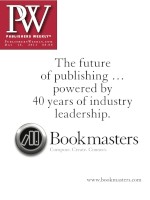An imprisoned serial killer helps London Det. Insp. Anna Travis track a serial killer on the loose in Lynda La Plante's Blind Fury.
What appealed to you about having a dual killer story line?
The appeal for me came from a meeting with a category "A" prisoner [a violent offender in the U.K.], who expressed his own hopes of writing a novel. He said he would be a perfect candidate to put down what a real killer felt as he'd committed murders. In the end, he began to give me tips about my own previous published works and how he would have written something different. I found his ego and his extraordinary obsessions fueled my imagination for Blind Fury.
The relationship—both intimate and professional—between Anna Travis and Det. Chief Supt. James Langton is a driving force in every book. Was it something you envisioned from the start?
Bringing the characters of Anna Travis and James Langton together was never plotted to be a continuing theme. However, the more I wrote about them, the more I enjoyed exploring these two complex people. It helps to have running alongside the novels the U.K. television series with Ciarán Hinds and Kelly Reilly playing the roles of Langton and Travis. It makes for even more enjoyment in writing their continued stories.
Comparisons are inevitable between Anna Travis and your most famous creation, Prime Suspect's Jane Tennison. What similarities and differences do you see between them, and why did you choose to write about another female police detective?
Anna Travis is really a young Jane Tennison, but with very marked differences. We first met Jane Tennison when she was a detective chief inspector in her 40s. She had come through the ranks, from uniform to flying squad to murder team. She was facing strong discrimination and was tough and hardened to deal with it. Anna Travis is a fast-track detective, never having been in uniform, and without the discrimination level that Tennison had to deal with. What interested me was that Travis has a university background as opposed to street experience. Gradually, we also see how Anna Travis grows into a formidable female detective and becomes as tough as Tennison.
Since you also write for television, what differences have you found between writing for the screen and the page?
The difference between writing for the screen and writing a novel is always cost. In a novel, I can have 70 characters, I can have helicopters, I can move to wherever I want, but on the screen I am writing for a specific time slot and I have to keep in mind the budget.



 Volume 258
Issue 20
05/16/2011
Volume 258
Issue 20
05/16/2011





